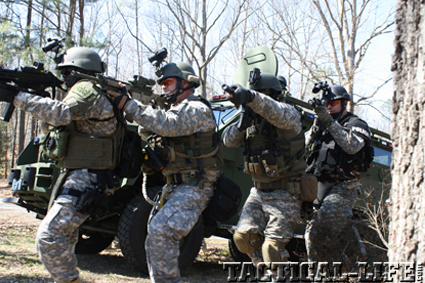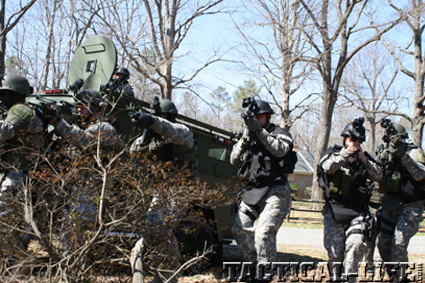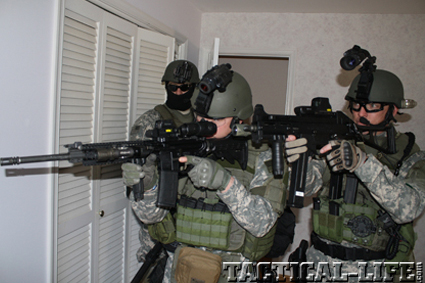Chesterfield County, Virginia, is a bucolic suburban community that includes commercial and rural areas.
It is also located just south of and adjacent to the state capital of Richmond, and Interstate 95 runs right through the county as well, meaning a certain amount of spillover does occur, which helps keep the county’s 22 SWAT members busy.
Protecting 437 square miles of territory and some 316,000 residents, the Chesterfield Police Department’s 500 officers possess a vast array of skills, and the SWAT team is recruited directly from this pool. Each team member does double duty, and all of them have primary roles other than SWAT. These include K9, detective, patrol, school protection, investigative, training and special enforcement duties.
Advertisement — Continue Reading Below
This diversity of skills and experience significantly contributes to the effectiveness of the team as a whole. The SWAT team features two main squads, green and gold, as well as two sniper teams, each composed of two snipers and two alternates. SWAT team duty can be very demanding, especially when training requirements are piled on top of an officer’s normal assignments.
Each member of the Chesterfield SWAT unit trains twice per month, once with their squad and once with the team as a whole. Each training takes an entire day. The sniper teams train independently for an additional six days per year, occasionally making use of the many military ranges available in Virginia for true long-range practice. Given the mixed suburban and rural makeup of the county, the sniper teams usually train at distances ranging from 100 to 400 yards.
All of this training doesn’t start until new team members, after meeting the entrance requirements for consideration, undergo a 40-hour Basic SWAT school. Team members also participate in various regional SWAT competitions to hone their skills, test gear and equipment under duress, and quantify their level of fitness and expertise with the department. The Chesterfield SWAT team has in fact won several events and has made equipment adjustments based on competition performance.
Advertisement — Continue Reading Below
Chesterfield County is in the process of building a new six-story training tower for the use of the fire department; however, it will also feature multiple breaching doors for SWAT use and rooftop helicopter skids for rappelling training. This expansion is part of the state-of-the-art Eanes-Pittman Public Safety Training Center, which is jointly managed to serve the needs of the police and sheriff’s departments as well as the county’s fire rescue brigade. Chesterfield SWAT team members have access to the training center’s multiple classrooms, role-playing rooms and a 25-yard, small-arms firing range divided into two bays capable of holding 10 officers each. The range can be used simultaneously for training scenarios and range qualifications, and uses moving pneumatic-actuated targets.
Close by is an emergency vehicle operators training area with over 1.5 miles of track and an observation tower. The course simulates various real-world driving conditions and scenarios, including traffic lights, high-speed pursuits, bridge transitions, cones, alleyways, railroad crossings, a skid pan and off-road recovery.
Guns & Gear
Advertisement — Continue Reading Below
SWAT officers keep all of their gear in their patrol vehicles for rapid responses. This consists of 40 to 50 pounds of body armor, a helmet with a night-vision monocular, shields, weapons, ammunition, communication gear and gas masks. The department’s standard patrol rifle is an ArmaLite AR-15 carbine with a mid-length gas system and topped of with an EOTech holographic sight. Some of the rifles are suppressed SBRs, and according to SWAT Commander Lt. Tim Spivey, the goal is to eventually suppress every one of the department’s rifles in order to help protect the officers’ hearing.
Some team members carry .40 S&W-chambered Heckler & Koch UMP or MP5 submachine guns, and all carry standard-issue Glock 22s—also in .40 S&W. Snipers are issued Accuracy International .308 rifles with Zeiss 4-14x50mm mil-dot scopes.
More specialized gear includes remote cameras for observation and various door breaching devices, as well as 40mm gas launchers. Currently, only SWAT is issued and is certified to use Tasers, which the team has put to good use on more than one occasion.
Advertisement — Continue Reading Below
One of the newest, and certainly the largest, pieces of equipment is a Lenco BearCat armored personnel carrier. Secured with the help of a Department of Homeland Security grant, this 17,000-pound vehicle can withstand calibers up to .50 BMG and comes with an integrated FLIR thermal imager. It will accommodate 10 fully geared officers inside and can transport the remainder of the team on dual external running boards. The BearCat also features a turret with an armored shield and view/firing port, multiple side and rear firing ports and a front-mountable ram for defeating barricaded or reinforced doors.
High-Risk Ops
The Chesterfield SWAT unit takes the lead in many specialized situations, including serving high-risk search and fugitive warrants. Most often, they deal with barricade situations, which can be extremely difficult, as suspects, typically armed and under the influence of drugs or alcohol, often threaten violence against themselves or others.
Advertisement — Continue Reading Below
Numerous SWAT callouts also involve individuals who are either mentally disturbed or are suffering from some other emotional trauma as a result of a domestic dispute or even post-traumatic stress disorder. This is just one reason the Chesterfield County SWAT team trains extensively for any situation and takes the utmost care to try to end confrontations with a minimal escalation of force as often as possible.
Sometimes a suspect will hold out for an extended period until negotiators let them know that they have minutes before the SWAT team moves in. This often elicits immediate compliance. During a long standoff, negotiators will communicate with a suspect while the SWAT team increases the suspect’s level of discomfort over time. Among the methods used are cutting off gas and electricity service and deploying flashbangs or gas.
One incident in particular saw the use of multiple devices. An intoxicated suspect had fired at a patrol officer responding to a disturbance call and subsequently barricaded himself. Complicating matters further, the suspect was a former police officer. During the 16-hour standoff, one sniper team member experienced hypothermia. The team deployed flashbangs near the exterior. Finally, distracting the suspect at the rear of the home, a second team made entry from the front and used a Taser to subdue the man on his back porch.
Advertisement — Continue Reading Below
In another incident, a barricaded suspect refused to exit his home despite the deployment of numerous gas grenades into the upper stories. The SWAT commander then noticed that the suspect appeared to be making an exit, but he merely stepped out, caught a few quick breaths of fresh air and went back inside. He did this a second time. Before his third attempt, officers moved in closer. When he came out for air, he was Tasered and subdued.
Chesterfield is the fourth largest municipality in Virginia, and the police department responds to over 200,000 calls each year. Still, limited resources are a challenge, and the SWAT team expands its capabilities significantly through partnerships with area agencies, including the state police. As such, Chesterfield SWAT has access to aircraft and bomb disposal units when needed.
Chesterfield County has a long tradition of law enforcement. The county has also been recognized as one of the safest and most secure communities of its size in the U.S. Chesterfield County SWAT’s professionalism, training and dedication play a major role in achieving that success. For more information, visit chesterfield.gov/police/.
Advertisement — Continue Reading Below





































